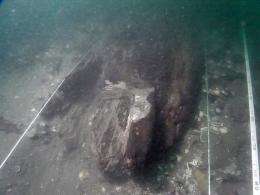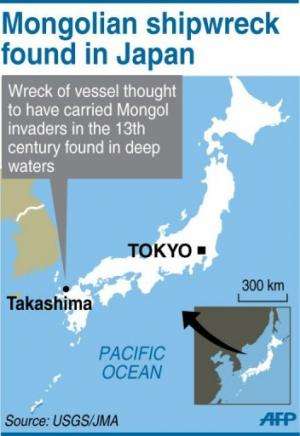Mongolian 'kamikaze' wreck found off Japan coast

The 13th century wreck of an invading Mongolian ship that fell victim to a famous typhoon known in Japan as the "kamikaze" or "divine wind" has been found off the country's southern coast.
A long section of the keel of a wooden vessel, thought to have been one of more than 4,000 sent by Kublai Khan to conquer Japan, was discovered beneath the sea bed near Nagasaki, the Mainichi Shimbun and other media reported.
The huge invading fleet of 1281 is believed to have been sunk by a powerful typhoon that became known in Japan as the "kamikaze" -- a "divine wind" that protected a chosen nation.
The wreck, which is buried in a metre (three feet) of mud, was found by a team led by Yoshifumi Ikeda, professor of archaeology at the University of the Ryukyus in Okinawa.
The team found a 12-metre section of the keel with several long pieces of wood attached.
Experts estimate the vessel was at least 20 metres long before it sank off the island of Takashima in northern Nagasaki prefecture.

Ikeda said a number of pieces of Chinese pottery dating from the 12th and 13th centuries were also found at the site, helping to pinpoint the age of the boat.
The Mongolian-ruled Yuan dynasty of China, led initially by Genghis Khan's grandson, Kublai, tried to conquer the samurai warriors of Japan on two occasions, in 1274 and 1281.
About 900 ships were sent in the first attempt. Battles were fought in Kyushu, Japan's main southern island, but the invasion attempt failed.
The much bigger, second fleet of 4,400 ships was largely sunk by the huge typhoon that the Japanese attributed to divine intervention, giving currency to the notion of "kamikaze", a word now largely associated with the suicide pilots of World War II.
Around 4,000 artefacts from the wreck, including the anchor, were previously known about, but researchers hope the discovery of such a large and well-preserved section of the boat will help them to understand more about the invading fleet.
"This discovery was of major importance for our research. We are planning to expand search efforts and find further information that can help us restore the whole ship," Ikeda said.
(c) 2011 AFP



















